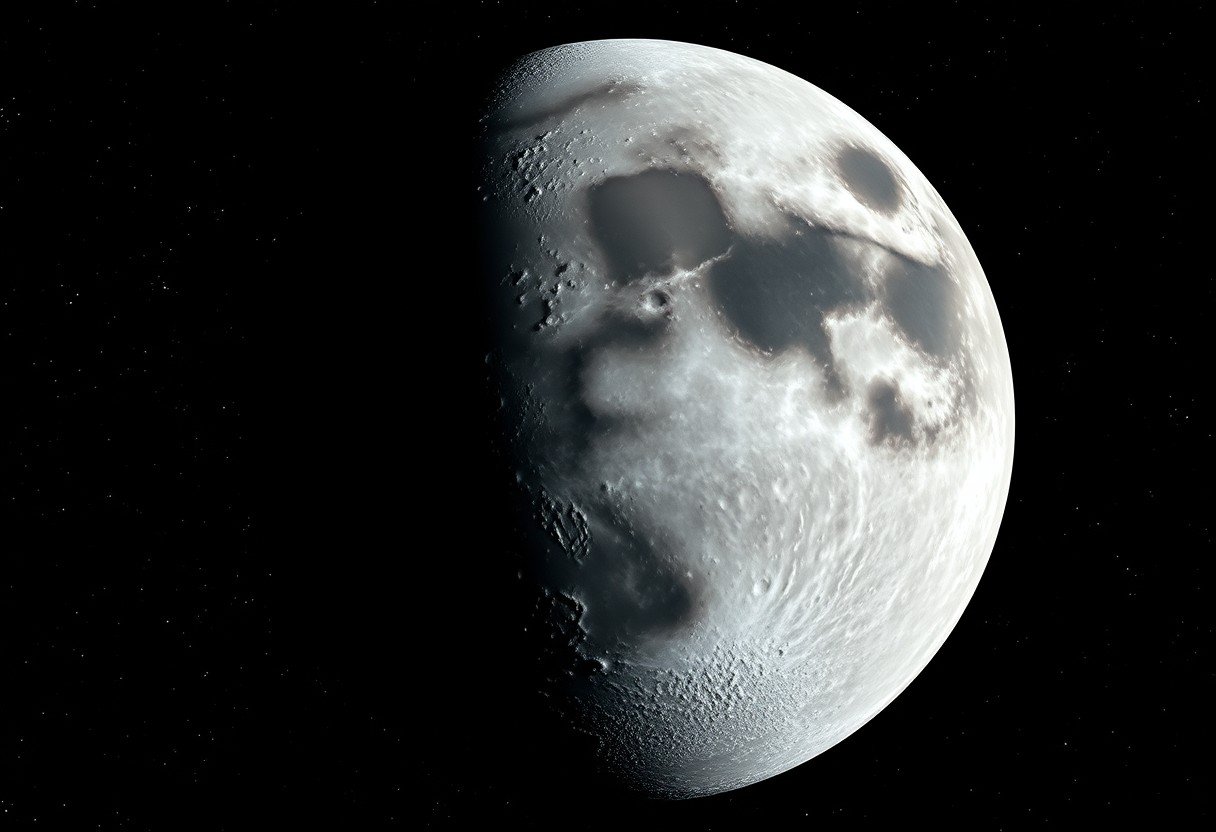Mass is a fundamental property of matter that remains constant regardless of location, unlike weight which can vary due to gravitational forces. If your mass is 60 kg on Earth, it stays the same on the Moon. However, the effect of gravity on weight differs significantly between these celestial bodies. On Earth, you experience a stronger gravitational pull, while the Moon’s weaker gravity means that your weight would be less. In this blog post, we’ll explore the concept of mass and weight in different gravitational fields, focusing on what this means for you when comparing Earth and the Moon.
Key Takeaways:
- Mass vs. Weight: Your mass, such as 60 kg, remains constant regardless of location; it does not change whether you are on Earth or the Moon.
- Moon’s Gravity: The Moon’s gravitational pull is about 1/6th that of Earth’s, which means you would weigh significantly less on the Moon compared to Earth.
- Weight Calculation: On the Moon, your weight would be approximately 10 kg (60 kg ÷ 6), illustrating how gravity affects weight but not mass.
- Impact on Movement: Less weight on the Moon means greater ease of movement and potential for jumping higher due to reduced gravitational resistance.
- Scientific Relevance: Understanding the difference between mass and weight is crucial in physics and engineering, especially for space exploration and astronaut training.
Understanding Mass and Weight
The concepts of mass and weight are fundamental in physics and help you understand how objects behave under various gravitational influences. While both terms are often used interchangeably in everyday language, they have distinct meanings. Mass refers to the amount of matter in an object, whereas weight is the force exerted by gravity on that mass. Knowing the difference between these two concepts is crucial, especially when exploring how your mass would change in different gravitational environments, like on the Moon.
Definition of Mass
With mass, you are measuring the quantity of matter that an object contains. It remains constant regardless of your location, whether on Earth, the Moon, or anywhere else in the universe. Therefore, if your mass is 60 kg on Earth, it will still be 60 kg on the Moon, highlighting that mass is an intrinsic property of matter.
Definition of Weight
One key aspect to remember is that weight is not a fixed value; it can change depending on the gravitational force acting on your mass. Weight can be calculated with the formula: weight = mass × gravitational acceleration. This means that even though your mass stays the same, your weight can differ in various gravitational fields.
For instance, on Earth, the gravitational acceleration is approximately 9.81 m/s², so your weight would be calculated as 60 kg × 9.81 m/s², giving you a weight of about 588.6 N (Newtons). However, on the Moon, where the gravitational acceleration is only about 1.62 m/s², the same mass would yield a much lighter weight—60 kg × 1.62 m/s², resulting in a weight of approximately 97.2 N. This illustrates how gravity plays a crucial role in determining your weight while your mass remains unchanged.
Gravitational Differences
It is necessary to understand the gravitational differences between Earth and the Moon to comprehend how they affect your mass. Gravity varies based on the celestial body you are on, influencing not just your weight but also your physical experiences, such as movement and stability.
Gravity on Earth
Any object on Earth experiences a gravitational pull of approximately 9.81 m/s². This force is what gives you your everyday weight and is a standard measure we often take for granted. Your mass remains constant regardless of location, but the force of gravity determines how heavy you feel.
Gravity on the Moon
Earth’s Moon has a gravitational pull of only about 1.62 m/s². This difference means that, on the Moon, you would weigh significantly less than you do on Earth, although your mass remains unchanged. The reduced gravity allows you to leap higher and move more freely, creating a unique experience.
Plus, the Moon’s lower gravity affects not only your weight but also your biomechanics. You would find that activities like jumping or running take less effort, making it easier to perform tasks. The decreased gravitational force can also influence your balance and coordination, as your body adapts to the lessened pull. This means you can enjoy a thrilling sense of weightlessness while exploring the lunar surface!
Calculating Mass on the Moon
Not only does the Moon have weaker gravitational pull than Earth, but it also offers a fascinating context for understanding mass. When you calculate your mass on the Moon, it remains unchanged at 60 kg—no matter where you are in the universe. However, your weight would differ significantly due to the Moon’s lower gravity, allowing you to experience a sense of lightness.
The Formula for Weight
Calculating your weight involves using the formula: Weight = Mass × Gravitational Acceleration. On Earth, the gravitational acceleration is approximately 9.81 m/s². On the Moon, this value is only about 1.62 m/s². By applying these values, you can easily determine your weight on both celestial bodies.
Mass Remains Constant
The distinction between mass and weight is crucial to understand. Your mass—measured in kilograms—remains constant regardless of your location in the universe. This means that whether you’re on Earth, the Moon, or beyond, your mass stays at 60 kg. It is a measure of the amount of matter in your body, unaffected by gravitational forces.
Weight, on the other hand, varies based on gravitational pull. Thus, while your mass remains 60 kg, your weight is considerably less on the Moon due to its weaker gravity. In essence, you can think of mass as the invariable component of your identity, while weight fluctuates along with the gravitational forces acting on you.
Weight Comparison: Earth vs Moon
Many people often confuse mass with weight, but they are distinct concepts. Your weight on Earth is significantly affected by the planet’s gravitational force, which is about six times stronger than that of the Moon. Take a look at the following comparison:
| Planet | Weight (N) |
|---|---|
| Earth | 588.6 N |
| Moon | 98.1 N |
Example Calculations
For instance, if your mass is 60 kg, your weight on Earth can be calculated using the formula: Weight = Mass × Gravity. Therefore, on Earth (9.81 m/s²), your weight would be approximately 588.6 N, while on the Moon (1.62 m/s²), it would be around 97.2 N.
Implications for Human Activity
Activity on the Moon is influenced by its weaker gravitational pull, which affects everything from movement to equipment design. For example, astronauts can jump higher and move more freely on the lunar surface, which could lead to new strategies for exploration and research.
This aspect of lunar gravity not only enhances mobility but also impacts the planning of habitats, building structures, and conducting scientific experiments. Lower weight may allow you to utilize lighter materials and innovative technologies that would be less feasible under Earth’s gravity, paving the way for unique advancements in space exploration and colonization strategies.

Effects of Reduced Gravity
Once again, the moon’s gravity is approximately 1/6th that of Earth’s, significantly altering how you experience weight and mobility. This reduced gravitational pull allows you to move with greater ease, jump higher, and feel lighter. However, it also means that your body will need to adapt to a new environment, affecting everything from your muscular strength to your balance and coordination.
Physical Impact on Humans
To fully understand the implications of reduced gravity, you must consider how your body responds to a lunar environment. Your muscles and bones may weaken over time due to decreased gravitational stress, potentially leading to health issues like osteoporosis. Additionally, cardiovascular and sensory systems may also face challenges, prompting careful consideration of long-term habitation and activity in such low-gravity environments.
Engineering Considerations
To effectively design habitats and equipment for lunar missions, engineers must account for the unique challenges posed by reduced gravity. This includes ensuring that structures are stable and can withstand dynamic loads, including those created by human movement and equipment operations.
The need for specialized engineering solutions is critical on the moon, where factors like dust, temperature fluctuations, and radiation come into play. Engineers must develop lightweight materials that enhance mobility while providing sufficient protection for inhabitants. Additionally, designing locomotion systems or alternative transportation methods will help you navigate the lunar surface efficiently and safely, leveraging reduced gravity for practical applications while ensuring your well-being in this alien environment.
Practical Applications
Unlike your weight, which changes depending on the gravitational pull of a celestial body, your mass remains constant regardless of location. Understanding this distinction is crucial for applications in various fields, especially in science and engineering. For instance, when planning missions to celestial bodies like the Moon, accurate calculations of mass are necessary for ensuring the safety and success of crewed and uncrewed operations.
Space Exploration
Space exploration endeavors to understand our universe better, and recognizing how your mass behaves on different celestial bodies is vital. When astronauts travel to the Moon, they need to be aware that their weight will decrease significantly due to the Moon’s lower gravity. This understanding aids in planning physical activities and equipment usage during missions.
Future Moon Missions
Exploration of the Moon has been reignited with various space agencies planning missions for the coming years. These missions emphasize the need to understand how your mass and weight will affect lunar activities, including walking on the surface and conducting experiments. Such knowledge is pivotal for training astronauts and designing missions that are efficient and safe.
A key aspect of future Moon missions, such as NASA’s Artemis program, aims to establish a sustainable presence on the lunar surface. This initiative will involve various tests that measure how astronauts’ mass affects their movements and physical tasks in reduced gravity. Understanding these dynamics equips space agencies with insights necessary for planning longer-duration lunar excursions and enhancing the safety and effectiveness of their operations.
Final Words
From above, it’s necessary to understand that your mass remains constant regardless of where you are in the universe; whether on Earth or the Moon, if your mass is 60 kg on Earth, it will still be 60 kg on the Moon. The distinction lies in weight, which changes due to the difference in gravitational pull—the Moon’s gravity is about one-sixth that of Earth’s. Thus, while your mass is unchanged, your weight on the Moon would significantly decrease, illustrating the unique relationship between mass and gravity.
FAQ
Q: If my mass is 60 kg on Earth, will my mass change on the Moon?
A: No, your mass will not change. Mass is a measure of the amount of matter in your body and remains constant regardless of location, whether on Earth, the Moon, or anywhere else in the universe. Therefore, if your mass is 60 kg on Earth, it will still be 60 kg on the Moon.
Q: What is the difference between mass and weight?
A: Mass is the quantity of matter in an object, measured in kilograms (kg), and it does not change regardless of gravitational influence. Weight, on the other hand, is the force exerted by gravity on an object and is calculated by multiplying mass by the gravitational acceleration (W = m × g). On Earth, gravity is approximately 9.81 m/s², while on the Moon it is about 1.62 m/s². Therefore, while your mass remains 60 kg, your weight would be different on the Moon compared to Earth.
Q: How do I calculate my weight on the Moon if my mass is 60 kg?
A: To calculate your weight on the Moon, you can use the formula W = m × g, where “W” is weight, “m” is mass, and “g” is the acceleration due to gravity (on the Moon, g ≈ 1.62 m/s²). For a mass of 60 kg: W = 60 kg × 1.62 m/s² = 97.2 Newtons. So, your weight on the Moon would be approximately 97.2 N (Newtons).
Q: Why does my weight change on the Moon if my mass does not?
A: Your weight changes because weight is dependent on the gravitational force acting on your mass. The Moon has a much weaker gravitational pull compared to Earth (about 1/6th of Earth’s gravity). Although your mass remains the same regardless of location, the weaker gravitational force on the Moon results in a significantly lower weight.
Q: Does the concept of mass being constant apply to all celestial bodies?
A: Yes, the concept of mass being constant applies to all celestial bodies. No matter where you are in the universe, your mass will not change; it will always remain the same as it reflects the total amount of matter in your body. However, your weight will vary based on the gravitational force of the celestial body you are on, such as Earth, the Moon, Mars, or other planets.








Leave a Comment